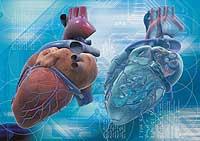Biomaterials in medicine
2004/06/01 Orive Arroyo, Gorka - Farmazian doktorea. Biofarmazia, Farmakozinetika eta Farmazia-teknologiako irakasle kolaboratzaileaFarmazia Fakultatea UPV-EHU, Vitoria-Gasteiz Iturria: Elhuyar aldizkaria

Biomaterials are materials composed of components of biological origin. Throughout history they have had great importance in the field of medicine and have been frequently used to treat diseases. For example, 2,000 years ago gold was applied in dentistry and in the past wooden teeth and glass eyes were also important.
XX. During the 20th century, biomaterials of natural and synthetic origin were very important to solve various alterations. For example, when the kidneys were unable to perform their function, cellulose acetate was used to treat dialysis and polyetherurethanes to form artificial hearts.
Characteristics of biomaterials
Biomaterials of medical interest must meet certain requirements before being used for therapeutic applications. Among other things, the materials must be biocompatible, that is, not damage the cells or the body itself. In turn, biodegradability is a very interesting property, as it allows the body to easily convert into non-toxic metabolic products. But other factors such as mechanical stability, ease of production and cost must be taken into account.
Currently, biomaterials research and production is a field of great importance from the health, economic and even social point of view. In order not to leave behind the leading research countries, it is necessary to develop all the possibilities offered by biomaterials and look for new applications. To meet these objectives, the CAPV will launch a research network in the coming years that aims to analyze the therapeutic potential of biomaterials.

In recent years the technology of biomaterials has been extended to therapeutic uses and to various scientific fields. Among the most promising applications are the generation of new medicines, textile engineering, the development of surgical techniques and diagnostic techniques.
Among the new medicines more comfortable and with better properties are those derived from polyethylene glycol (PEG). The PEG polymer is able to modify the pharmacokinetic characteristics of the drugs, that is, the drugs that are removed quickly, so they must be administered three or four times a day, only once a day thanks to complex polymers.
This improvement allows patients to take increasingly safe medicines. But the influence of polymers is not limited to that. According to the latest data, millions of people worldwide use drugs produced in polymers like patches, contact lenses, fillings, etc. every year.
On the other hand, the combination of polymers and human cells makes researchers capable of developing tissues and organs. The objective of this area, known as tissue engineering, is to recover, maintain or improve the function of tissues or organs originating in patients. For example, artificial skin has now been used to heal wounds and especially burns. Corneas, cartilage, bones, liver, and urinary bladder are also in clinical trials to evaluate their effectiveness.
Simpler surgeries

Surgical techniques and medical applications have also been developed significantly thanks to the use of biological materials. Polymers with “aspect memory” stand out. The appearance and size of these materials varies depending on the temperature. And if the desired shape and size are adopted according to body temperature, simpler surgical techniques, such as an implant, will suffice. With the help of these polymers, surgical techniques can become minimal.
Finally, the devices used to know and analyze gene expression and protein functions have improved significantly thanks to polymers. Among other applications, these systems are very useful for the detection of carcinogenic genes.
Looking ahead, we can dream of more biocompatible biomaterials that respond to all the changes of our body. This will require more scientific research to deepen the knowledge of researchers.
Robert Langer, biomaterials expert
If we are looking for someone responsible for the development of biomaterials, this is undoubtedly the prestigious scientist Robert Langer. Born in the United States, he is a professor of chemical and biomedical engineering, with more than 800 scientific articles and more than 500 patents. He has been a member of the US FDA (Food and Drug Administration) that accepts food and drugs and is currently a professor at MIT (Massachusetts Institute of Technology).

Mr. Robert Langer has responded with great kindness to various questions related to biomaterels:
What influence do biomaterials have on science and medicine?
The importance of biomaterials is enormous and are fundamental for obtaining certain medicines and medical systems.
Can we say that we know the full potential of biomaterials?
In no case. In the future, biomaterials will participate directly in the development of new medical systems.
What properties should the right material have?
Safety, mechanical strength and ability to perform the desired therapeutic function.
What are the limits of biomaterials?
A lot, unfortunately. For example, improve biocompatibility and achieve more controlled degradation.
In what applications do we use biomaterials in our daily lives?
Skin patches, seams, contact lenses, etc.
Which biomaterials are the most used?
Used in bioadhesives and fillers.
How do biomaterials affect the economy?
Europe and the United States annually obtain more than 75 million dollars with the sale of biomaterials.
What will biomaterials offer us in the future?
Different treatments and medications that improve and extend our lives.
G. Orive
BIBLIOGRAPHY
- Dunkan, R. ‘The dawning era of polymer therapeutics’ Nat. Rev. Drug Discov 2:347-360 (2003).
- Langer, R. and others ‘Where a pill won´t research’ Sci. Am. 288:50-57 (2003).
- Orive, G. and others ‘Fabric engineering: XXI. Elhuyar Zientzia eta Teknika 190:14-17 (2003).

Gai honi buruzko eduki gehiago
Elhuyarrek garatutako teknologia






